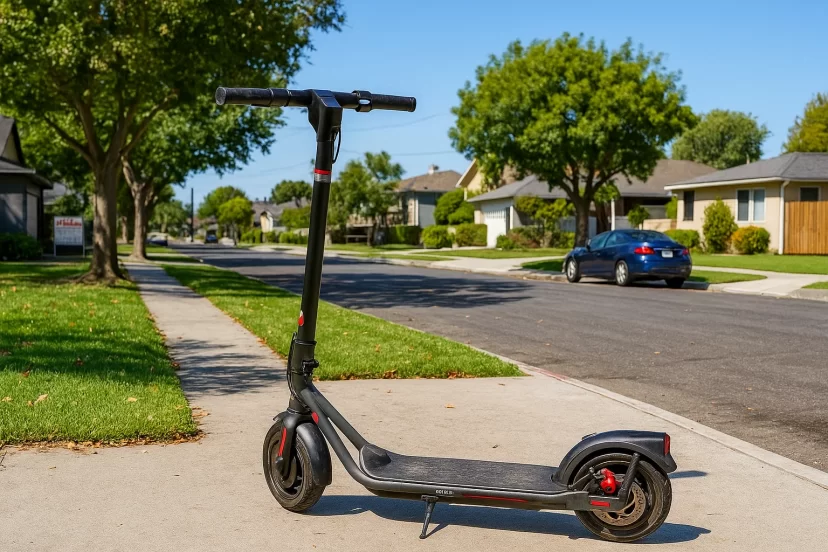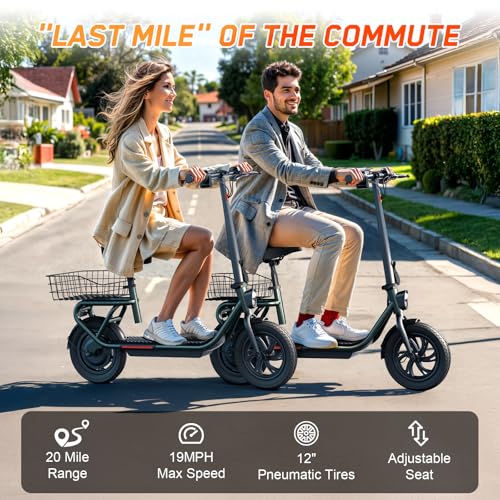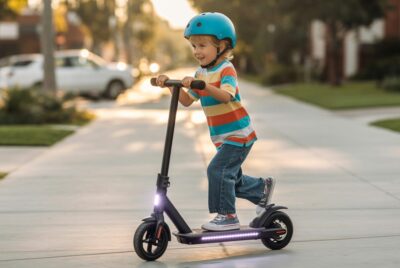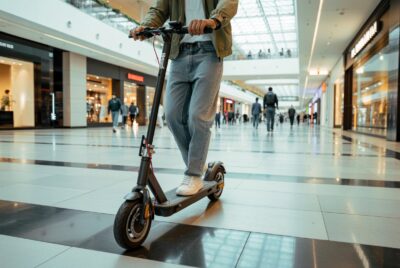TST Electric Scooter Guide
*We may earn a commission for purchases made using our links. Please see our disclosure to learn more.
The morning commute doesn’t have to be a soul-crushing experience of traffic jams and crowded public transport. Picture this: gliding through city streets with the wind in your hair, effortlessly navigating around gridlock, and arriving at work energized instead of exhausted. This is the reality that TST electric scooters bring to thousands of urban commuters who’ve discovered a better way to move through their cities.
Electric scooters have revolutionized urban transportation, and TST has emerged as a brand that understands what riders truly need. Whether you’re tired of expensive gas prices, frustrated with parking nightmares, or simply looking for a more enjoyable way to get around, the journey to finding the perfect electric scooter can feel overwhelming. With countless options flooding the market, how do you choose a ride that won’t let you down?
The transformation from car-dependent commuter to confident scooter rider doesn’t happen overnight. It’s a journey filled with questions, doubts, and small victories. But understanding what makes a quality electric scooter—and specifically what TST brings to the table—can make all the difference between a purchase you’ll regret and a transportation solution that changes your daily life.
“The transformation in urban mobility isn’t about replacing all cars—it’s about giving people options that match their specific needs. Electric scooters fill a crucial gap between walking and driving, making short-to-medium distance travel faster, cheaper, and more enjoyable.”
— Urban Transportation Research Institute, 2024
Key Takeaways
- TST electric scooters offer reliable urban transportation with features designed for daily commuters who value durability and performance
- Range and battery life are critical factors that determine whether your scooter meets your daily needs without constant recharging
- Weight capacity and build quality directly impact your scooter’s longevity and ability to handle various rider types and terrain
- Safety features like reliable braking systems and lighting are non-negotiable for anyone riding in urban environments
- Portability and folding mechanisms matter significantly if you need to carry your scooter on public transport or store it in tight spaces
Top TST Electric Scooter
TST HY-B15 Electric Scooter for Adults
Upgrade your daily commute with the TST Electric Scooter for Adults, a sleek, durable, and high-performance e-scooter designed for both convenience and style. Powered by a 500W peak motor (350W average), it can reach speeds of up to 19 MPH and travel as far as 20 miles on a single charge. The rear-wheel drive system ensures smoother acceleration, improved traction, and greater stability on hills or slippery surfaces—making it a reliable choice for city riders.
The TST Electric Scooter is designed to make your urban travel faster, smarter, and safer. Built with a robust 500W motor, this scooter achieves speeds up to 19 MPH and covers a range of up to 20 miles per charge—perfect for daily commutes or leisure rides. Its rear-wheel drive setup ensures a balanced and secure experience, offering superior traction on inclines and wet roads compared to front-wheel models.
- Strong Motor Power: Reaches speeds up to 19 MPH with a 500W peak motor—ideal for daily commutes and short-distance travel.
- Smart App Control: Manage cruise control, lights, and scooter settings directly from your phone for a modern riding experience.
- Enhanced Safety: Features dual braking, automatic headlights, and UL2272 certification for dependable, worry-free rides.
- Moderate Range: The 15–20-mile limit may not be enough for long-distance commuters.
- Slightly Heavy: At 32 pounds, it’s not the lightest option for carrying long distances.
- Charging Time: Requires several hours to fully recharge before the next use.
TST HY-B18-Pro Electric Scooter for Adults
Take your daily commute or weekend rides to the next level with the TST Electric Scooter, engineered for both power and comfort. Featuring a 500W to 700W peak brushless motor, this e-scooter delivers thrilling top speeds of up to 23 MPH and an impressive range of 15–30 miles per charge. Whether you’re weaving through city streets or gliding along open paths, the TST scooter offers reliable performance and control.
The TST Electric Scooter redefines what it means to travel smart in the city. Equipped with a high-torque 500W/700W motor, it reaches speeds up to 23 MPH and covers up to 30 miles on a single charge—perfect for long commutes or weekend adventures. Riders can rely on its dual shock absorbers and solid tires for a smooth, safe ride on various surfaces, while the foldable aluminum frame offers unmatched portability for storage or transport.
- Strong Motor Power: 500W/700W peak motor delivers up to 23 MPH speed for fast and efficient travel.
- Smooth Ride: Dual shock absorbers and solid tires reduce bumps and vibrations on rough roads.
- Smart App Features: Bluetooth app control allows easy monitoring, cruise control, and performance customization.
- Moderate Weight: At around 40 lbs, it may feel a bit heavy for frequent carrying.
- Solid Tires: Less cushioning compared to pneumatic tires on rough terrain.
- Charge Time: Full battery recharge can take several hours depending on usage.
TST Electric Scooter HY-B18 Pro
The TST Electric Scooter HY-B18 Pro redefines urban commuting with its balance of power, comfort, and portability. Designed for adults who want speed, style, and safety in one foldable package, this e-scooter features a 700W peak brushless motor that reaches up to 23 MPH and covers an impressive 30-mile range per charge.
If you’re searching for an eco-friendly and high-performance way to commute, the TST Electric Scooter is your answer. Built for urban mobility, this scooter combines powerful engineering with intelligent features. Its 700W brushless motor easily conquers hills and maintains a top speed of 23 MPH, while its 30-mile range ensures you can travel farther without frequent recharging.
- Powerful Performance: 700W peak motor provides fast acceleration and stable speed up to 23 MPH.
- Comfortable Ride: Dual suspension system and solid tires absorb shocks for smooth rides on varied terrain.
- Smart Features: App connectivity with cruise control and lighting customization for a seamless riding experience.
- Charging Time: Full charge can take several hours depending on battery level.
- Limited Weight Capacity: Best suited for riders under 220 lbs.
- No Detachable Battery: Entire scooter must be brought to the charging outlet.
Understanding the TST Electric Scooter Appeal
The electric scooter revolution isn’t just about getting from point A to point B—it’s about reclaiming your time, your budget, and your sanity. Every rider who makes the switch has a story about that breaking point: the day they spent an hour in traffic for a 10-minute drive, the parking ticket that cost half a week’s grocery budget, or the stuffy subway car that made them question their life choices.
TST electric scooters entered the market with a clear mission: provide reliable, affordable transportation without the complications that plague cheaper alternatives. The brand focuses on durability, reasonable pricing, and features that actually matter to real riders navigating real cities. It’s not about having the flashiest design or the most aggressive marketing—it’s about showing up day after day, commute after commute, without leaving riders stranded.
What sets quality electric scooters apart isn’t just the specs on paper. It’s the engineering decisions that become apparent after weeks and months of use. It’s the motor that still performs smoothly after hundreds of miles. It’s the battery that doesn’t suddenly lose half its capacity after a few charge cycles. It’s the frame that doesn’t develop rattles and squeaks that make you cringe every time you hit a bump.
The Journey from Skeptic to Believer
Many riders approach their first electric scooter with a mix of excitement and trepidation. Can this really replace other forms of transportation? Is it safe? Will it actually save money, or is it just another gadget that’ll collect dust in the garage?
The transformation typically happens in stages. First comes the novelty phase—those first few rides where everything feels new and slightly thrilling. You’re learning the controls, getting comfortable with the acceleration, and figuring out the best routes through your neighborhood. There’s an undeniable joy in discovering shortcuts you never knew existed, paths that were always there but never accessible by car.
Then comes the practical phase, where the scooter proves its worth through daily use. You start calculating the savings: no more gas, no more parking fees, no more insurance premiums. You notice the time savings too—those routes where you’d sit in traffic for 20 minutes now take 10 minutes of pleasant riding. The exercise, while modest, starts adding up. Your mood improves because you’re starting and ending your day with fresh air instead of frustration.
Overcoming Initial Challenges
Every new electric scooter rider faces hurdles. The first time you encounter a steep hill, you wonder if your scooter has enough power. The first time it rains, you worry about safety and water damage. The first time your battery runs low mid-journey, you experience range anxiety in its purest form.
These challenges force you to learn and adapt. You discover which routes work best for your scooter’s capabilities. You learn to charge strategically, plugging in at work or timing your charges to always maintain adequate range. You invest in proper rain gear and learn which weather conditions are safe for riding versus when it’s better to use backup transportation.
The learning curve isn’t steep, but it is real. Understanding your scooter’s braking distance, especially in wet conditions, is crucial. Learning to read road surfaces—spotting potholes, uneven pavement, and gravel patches before they cause problems—becomes second nature. Mastering the art of smooth acceleration and deceleration makes rides more comfortable and conserves battery life.
What Makes a Quality Electric Scooter
Not all electric scooters are created equal, and the difference between a quality ride and a disappointing purchase often comes down to specific features that manufacturers either prioritize or cut corners on.
Motor Power and Performance
The motor is the heart of any electric scooter, and there’s a significant difference between motors designed for occasional use versus daily commuting. A quality motor doesn’t just provide adequate power—it delivers consistent performance across various conditions. Climbing hills, accelerating from stops, and maintaining speed on longer rides all depend on motor quality.
TST electric scooters typically feature motors in the 250W to 500W range, which strikes a balance between power and efficiency for urban riding. This isn’t about raw speed—most cities have regulations limiting scooter speeds anyway—it’s about having enough power reserve to handle real-world conditions without straining the motor and draining the battery prematurely.
Battery Capacity and Range
Range anxiety is real, and nothing kills the electric scooter experience faster than constantly worrying about running out of power. Quality scooters use lithium-ion batteries that provide reliable range estimates and maintain their capacity over hundreds of charge cycles.
The advertised range on any scooter is typically calculated under ideal conditions: flat terrain, optimal temperature, average rider weight, and moderate speed. Real-world range is usually 20-30% less, which is why it’s crucial to choose a scooter with more range than your minimum daily needs. If your round-trip commute is 10 miles, a scooter with 15 miles of advertised range might leave you cutting it close, especially as the battery ages.
Understanding battery maintenance extends your scooter’s lifespan significantly. Avoiding complete discharges, storing the scooter in moderate temperatures, and following proper charging protocols can mean the difference between a battery that lasts two years versus one that needs replacing after six months.
Build Quality and Durability
The frame, deck, and overall construction determine whether your scooter feels solid or sketchy. Quality materials and proper engineering create a ride that inspires confidence rather than constant worry about structural integrity.
Aluminum alloy frames provide the sweet spot of strength and weight. Steel is stronger but heavier, making scooters less portable. Carbon fiber is lighter but expensive and potentially less durable for daily abuse. The welding quality, joint reinforcement, and overall build tolerances separate premium scooters from budget models that develop wobbles and rattles after minimal use.
Weight capacity matters more than many riders realize. A scooter rated for 220 pounds doesn’t mean it’ll collapse at 225 pounds, but consistently riding near or above the weight limit accelerates wear on all components—tires, suspension, frame, and motor. Choosing a scooter with weight capacity well above your needs provides a margin of safety and longevity.
Safety Features That Actually Matter
Safety isn’t just about following traffic laws and wearing a helmet—though those are crucial. It’s about having a scooter equipped with features that help you avoid accidents in the first place.
Braking Systems
The braking system is your primary safety feature, and the difference between adequate and excellent brakes can prevent serious accidents. Quality electric scooters use dual braking systems—typically combining electronic brakes with mechanical disc or drum brakes.
Electronic brakes alone, while convenient and smooth, don’t provide enough stopping power in emergency situations. Mechanical brakes give you that final stop authority when you need it most. The best systems blend both types seamlessly, with the electronic brake handling most stopping duties while the mechanical brake provides backup and emergency stopping power.
Learning your scooter’s braking characteristics is essential. Different surfaces—wet pavement, gravel, leaves, painted lines—all affect braking distance. Practicing emergency stops in a safe environment helps you understand your scooter’s limits before you need that knowledge in a real emergency.
Lighting and Visibility
Being seen is just as important as seeing where you’re going. Quality scooters include front headlights, rear brake lights, and side reflectors as standard equipment. These aren’t optional accessories—they’re essential safety features that should influence your purchase decision.
Many riders underestimate how invisible they are to drivers, especially during dawn, dusk, and nighttime riding. A bright headlight serves double duty: illuminating your path and making you visible to oncoming traffic. Brake lights that activate when slowing down alert drivers behind you, potentially preventing rear-end collisions.
Additional visibility measures—reflective clothing, helmet lights, and even LED strips on your scooter—might feel excessive, but they’re insurance against the driver who isn’t paying attention.
Tire Selection and Maintenance
Tires are your only contact with the road, making them critical for both safety and comfort. Electric scooters typically use either pneumatic (air-filled) or solid tires, each with distinct advantages.
Pneumatic tires provide superior shock absorption and traction, making rides more comfortable and providing better grip in wet conditions. However, they require maintenance and can suffer punctures that leave you stranded. Solid tires eliminate flat worries but transmit more road vibration to the rider and offer less traction.
Many serious riders keep a repair kit handy when using pneumatic tires—a small investment that can save a long walk home. Regularly checking tire pressure and tread wear prevents problems before they become dangerous.
Creating Your Ideal Commuting Setup
Transitioning to electric scooter commuting involves more than just buying a scooter and hitting the road. It requires planning, preparation, and building a system that works reliably day after day.
Route Planning and Optimization
Your car’s fastest route isn’t necessarily your scooter’s best route. Bike lanes, trails, and quieter streets might add a few minutes but dramatically improve safety and enjoyment. Many riders discover that their scooter commute, while covering more distance than a direct car route, takes less time door-to-door because of eliminated parking hassles.
Scouting routes before committing to daily use reveals potential problems. That hill that looks manageable might be steeper than expected. That bike lane might disappear halfway through, forcing you onto busy streets. That shortcut through the park might be perfect on dry days but becomes a muddy mess after rain.
Smart riders develop primary and backup routes, plus contingency plans for weather, equipment problems, or unexpected obstacles. Having options reduces stress and keeps you moving even when conditions aren’t ideal.
Weather Considerations and Gear
Weather resistance varies dramatically between scooter models. Some handle light rain without issues, while others should never get wet. Understanding your scooter’s limitations prevents damage and keeps you safe in marginal conditions.
Building a weather-appropriate gear collection happens gradually but pays dividends. A quality waterproof jacket, good gloves for cold mornings, and clear glasses for wind protection transform uncomfortable rides into manageable ones. Some riders keep full rain gear at work, eliminating the need to carry it on clear days.
Knowing when to skip the scooter and use backup transportation is wisdom, not weakness. Heavy rain, ice, snow, and extreme temperatures present safety risks that no amount of gear fully mitigates. Having a plan B—whether public transport, ride-sharing, or a traditional bicycle—keeps you moving without taking unnecessary chances.
Maintenance and Longevity
Electric scooters require less maintenance than cars or motorcycles but aren’t maintenance-free. Establishing a regular care routine prevents small problems from becoming expensive repairs.
Regular Maintenance Tasks
Basic maintenance is straightforward and requires minimal tools or expertise. Checking tire pressure weekly, tightening loose bolts monthly, and cleaning dirt and debris after rides through rough conditions keeps your scooter running smoothly.
The battery requires attention beyond just charging. Storing your scooter at moderate temperatures extends battery life significantly. Extreme heat or cold degrades battery chemistry, reducing capacity and shortening lifespan. If you won’t ride for an extended period, storing the battery at 50-70% charge is better than leaving it fully charged or depleted.
Brake adjustment becomes necessary as pads wear. Ignoring brake maintenance until they fail is dangerous and potentially damages other components. Learning to adjust brakes yourself saves money and ensures they’re always performing optimally.
When to Upgrade Components
Quality scooters allow component upgrades that extend lifespan and improve performance. Tires wear out, batteries eventually degrade, and brake pads need replacement. Knowing when to upgrade versus when to replace the entire scooter depends on the scooter’s overall condition and your needs.
Upgrading tires can dramatically improve ride quality and safety. Switching from solid to pneumatic tires (if your scooter supports it) transforms the riding experience. Choosing tires with better tread patterns improves wet weather traction.
Battery replacement, while expensive, often makes sense for an otherwise solid scooter. A new battery effectively gives you a new scooter for a fraction of the replacement cost. However, if multiple components need attention simultaneously, replacement might be more economical than extensive repairs.
The Hidden Benefits of Scooter Commuting
Beyond the obvious advantages of cost savings and convenience, electric scooter commuting brings unexpected benefits that improve overall quality of life.
Physical and Mental Health Impact
While electric scooters don’t provide intense exercise, they’re not entirely passive either. Balancing, steering, and maintaining posture engages core muscles and improves balance. It’s certainly more active than sitting in a car or on a train.
The mental health benefits often surprise riders. Starting your day with fresh air and mild physical activity, rather than stress and frustration, sets a positive tone. The sense of autonomy and control—choosing your route, timing, and pace—provides psychological benefits that extend beyond the commute itself.
Many riders report improved mood and reduced stress after switching to scooter commuting. The combination of light exercise, outdoor exposure, and avoiding traffic frustration creates a recipe for better mental health. It’s not a cure for serious mental health issues, but it’s a positive lifestyle change that accumulates benefits over time.
Environmental and Community Impact
Every car trip replaced with a scooter ride reduces emissions, traffic congestion, and noise pollution. While individual impact feels small, collective adoption of micro-mobility solutions significantly improves urban environments.
Being part of the growing electric scooter community creates connections you’d never make trapped in a car. A friendly wave to another rider, conversations with curious pedestrians, and the shared experience of choosing alternative transportation build community in unexpected ways.
Common Mistakes and How to Avoid Them
Learning from others’ mistakes is cheaper and less painful than making them yourself. Here are pitfalls that trap many new electric scooter riders.
Underestimating Range Requirements
Buying a scooter with barely adequate range seems economical until you experience range anxiety daily. Always add a safety margin to your range calculations. That 12-mile round-trip commute needs a scooter with at least 16-18 miles of real-world range, not just 12 miles of advertised range.
Battery capacity degrades over time, temperatures affect range, and headwinds consume more power than you’d expect. Hills are battery killers—climbing significantly reduces range while descending barely helps through regenerative braking. Planning for worst-case scenarios prevents getting stranded.
Skipping Safety Gear
The temptation to skip safety gear on short trips or beautiful days is strong, but accidents don’t schedule themselves around your convenience. A helmet takes seconds to put on but can save your life or prevent life-altering injuries.
Quality safety gear doesn’t have to be expensive or uncomfortable. Modern helmets are lightweight and well-ventilated. Gloves protect your hands in falls and improve grip. Reflective elements and lights are cheap insurance against visibility-related accidents.
Neglecting Local Regulations
Electric scooter laws vary widely between cities, states, and countries. Assuming what’s legal in one place applies everywhere leads to tickets, confiscated scooters, and potential legal problems. Research local regulations before buying, and respect them even if they seem overly restrictive.
Speed limits, where you can ride, parking rules, and age restrictions exist for reasons—even if those reasons aren’t always clear. Following regulations keeps you safe, maintains good relationships with pedestrians and drivers, and protects the broader electric scooter community’s reputation.
Building Long-Term Success
The difference between riders who abandon their scooters after a few months and those who maintain consistent use for years comes down to realistic expectations and proper planning.
Setting Achievable Goals
Committing to scooter commuting 100% of the time is ambitious but often unrealistic. Weather, maintenance needs, and life circumstances will force backup plans. Starting with a goal like “scooter three days per week” and building from there creates sustainable habits.
Celebrating small victories maintains motivation. That first week without driving, completing your longest ride, or handling a challenging route successfully all deserve recognition. Building positive associations with scooter riding through small wins creates lasting habits.
Adapting to Seasonal Changes
Year-round scooter commuting requires adapting strategies as seasons change. Summer might mean riding early to avoid heat, while winter requires layering for cold. Fall leaves become slippery hazards, and spring rain tests your weather gear.
Some riders embrace seasonal variation, using it as an excuse to try new routes or focus on different aspects of riding. Others maintain consistent patterns by investing in season-appropriate gear. Either approach works as long as you’re adapting rather than fighting against seasonal realities.
The Financial Reality
Understanding the true cost of electric scooter ownership prevents surprises and helps justify the investment.
Initial Investment Versus Long-Term Savings
Quality electric scooters range from a few hundred to over a thousand dollars—a significant upfront cost that feels daunting. However, comparing this to ongoing car expenses, public transit passes, or ride-sharing costs reveals potential savings that accumulate quickly.
The break-even point varies based on what you’re replacing. Someone eliminating a car payment and insurance breaks even faster than someone simply reducing ride-sharing frequency. Calculate your specific situation to understand when the scooter pays for itself.
Hidden costs include replacement parts, safety gear, and accessories like locks and phone mounts. Budgeting for these expenses prevents the frustration of unexpected costs derailing your scooter plans.
Value of Time Savings
Financial calculations typically focus on direct costs, but time savings represent real value. Spending 30 minutes instead of an hour commuting returns time you can use for work, family, hobbies, or rest. Over a year, this accumulates to weeks of recovered time.
Reduced stress and improved health have economic value too, even if they’re hard to quantify. Fewer sick days, better productivity, and improved quality of life all contribute to the return on investment, even if they don’t show up on a spreadsheet.
Looking Forward: The Future of Urban Mobility
Electric scooters represent one piece of a broader transformation in how we move through cities. Understanding where this technology is heading helps make informed decisions about current purchases.
Technology Improvements
Battery technology continues advancing rapidly. Future scooters will offer longer range, faster charging, and longer-lasting batteries. Motor efficiency improvements will provide more power without increasing energy consumption. Smart features like GPS tracking, integrated navigation, and app-based diagnostics will become standard.
These improvements don’t make current scooters obsolete—they simply mean the already-excellent option of electric scooter commuting will continue improving. Early adopters benefit now while future buyers will enjoy enhanced capabilities.
Infrastructure Development
Cities increasingly recognize micro-mobility’s role in solving transportation challenges. Protected bike lanes, dedicated scooter parking, and charging infrastructure will expand, making scooter commuting safer and more convenient.
This infrastructure investment creates a positive feedback loop: better infrastructure encourages more riders, more riders justify additional infrastructure investment. Being part of this movement early means influencing how your city adapts to changing transportation needs.
Final Thoughts: Your Journey Begins Now
Every journey starts with a single decision to try something different. For thousands of riders, that decision to try an electric scooter transformed their daily experience, their budget, and their relationship with their city.
TST electric scooters offer an entry point into this transformed lifestyle without requiring expert knowledge or excessive investment. They’re tools designed for real people facing real transportation challenges—not toys for hobbyists or status symbols for early adopters.
The path from curious observer to confident rider isn’t always smooth. There will be learning curves, challenges, and moments of doubt. But there will also be moments of joy—the first time you zip past gridlocked traffic, the morning you realize your commute has become the best part of your day, or the calculation that shows how much money you’ve saved.
Your specific needs, commute, and situation determine whether an electric scooter makes sense. But if you’re tired of the status quo, frustrated with current transportation options, or simply curious about a better way to move through your city, exploration costs nothing. Research thoroughly, consider your specific requirements, and make an informed decision about whether electric scooter commuting fits your life.
The electric scooter revolution isn’t coming—it’s already here. The only question is whether you’ll be part of it.
Frequently Asked Questions
What is the average lifespan of a TST electric scooter battery?
Most electric scooter batteries, including those in TST models, last between 300-500 full charge cycles before capacity noticeably decreases. With proper care—avoiding extreme temperatures, not fully depleting the battery regularly, and following recommended charging practices—expect 2-3 years of reliable battery life for daily commuters. Heavy use or poor maintenance can shorten this, while careful usage can extend it beyond three years.
Can electric scooters be used in the rain?
Many electric scooters have water resistance ratings (typically IP54 or higher), meaning they can handle light rain and splashes but aren’t fully waterproof. Riding in light rain is generally safe if your scooter has adequate water resistance, but avoid heavy downpours and deep puddles. Always check your specific model’s IP rating and dry your scooter after wet rides. Wet conditions also reduce traction and braking effectiveness, so adjust your riding style accordingly.
How fast do TST electric scooters typically go?
Most TST and similar electric scooters designed for urban commuting reach maximum speeds between 15-25 mph, depending on the model and motor power. However, your actual speed will be affected by rider weight, terrain, battery level, and weather conditions. Many cities regulate maximum electric scooter speeds, typically limiting them to 15-20 mph on bike lanes and streets. Always check and follow local speed regulations.
What maintenance does an electric scooter require?
Regular maintenance includes checking tire pressure weekly (for pneumatic tires), tightening bolts and screws monthly, cleaning the scooter after muddy or dusty rides, and inspecting brakes regularly. Battery maintenance involves proper charging habits and storage at moderate temperatures. Most riders should plan for tire replacement every 500-1000 miles, brake pad replacement every 300-600 miles (depending on usage), and potential battery replacement after 2-3 years. Professional servicing once or twice yearly catches issues before they become serious problems.
Are electric scooters legal everywhere?
Electric scooter regulations vary significantly by location. Some cities fully embrace them with dedicated infrastructure, while others ban them entirely or restrict where they can be used. Common regulations include age requirements (typically 16 or 18+), helmet mandates, speed limits, and restrictions on sidewalk riding. Some areas require registration or insurance. Before purchasing or riding an electric scooter, research your local, city, and state regulations. Laws continue evolving as electric scooters become more common, so check for updates periodically.













